As a minor deity Concordia originally personified peace and harmony between the plebeian and patrician orders. According to tradition M. Furius Camillus dedicated the first Roman temple to her in 367 BC. She is also identified with the Greek goddess of harmony Homonoia. Concordia appears as the personification of harmony and concord on Roman coinage and obverse images usually depict her as a matrona, veiled and draped. Reverse types show her either seated or standing; sometimes holding a patera; cornucopiae; a sceptre; a statuette of Spes; or in rare instances, an olive branch or flower. She is also associated with the stork (family devotion) and a dove (peace), or a star (hope).
During the Empire imagery of Concord is often seen on coins of empresses. The antoninianus (above right) of Otacilia Severa, consort of Philip I, shows Concord seated, holding a patera and cornucopiae. During the more tolerant reign of Philip and Otacilia, despite continued unrest in the Roman provinces, one can say that in contrast with former reigns, a degree of harmony was evident between the emperor, senate and the people. |


